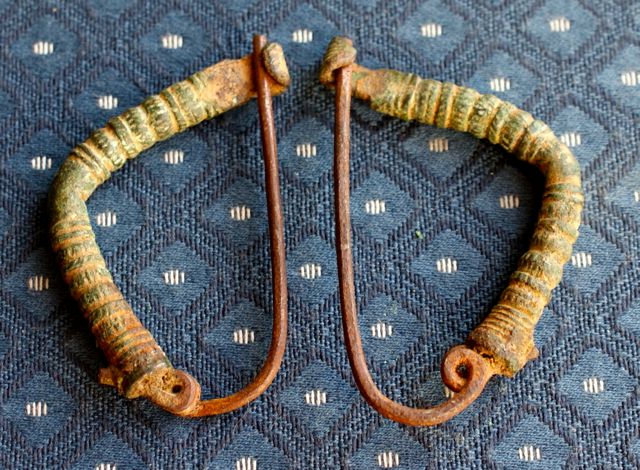Phrygian Fibulae
Asymmetric Bow with Enlargement Between Two Buttons (Blinkenberg XIII.1)
I-bar Bow (Blinkenberg XIII.2)
Semi-Circular Bow with Moulded Pearls (Blinkenberg XIII.3)
Semi-Circular Bow with Four Spherical Buttons and One Rectangular Plate (Blinkenberg XIII.4)
Semi-Circular Moulded Bow (Blinkenberg XIII.5)
Slightly Curved Bow with Moulded Extremities (Blinkenberg XIII.6)
Bow with Pairs of Rings Between Three Buttons (Blinkenberg XIII.7)
Plain Bow (Blinkenberg XIII.8)
Bow with Moulded Extremities (Blinkenberg XIII.9)
Elbow Bow with Two Buttons (Blinkenberg XIII.10)
Elbow Bow with Two Pairs of Buttons (Blinkenberg XIII.11)
Richly Moulded Elbow Bow (Blinkenberg XIII.12)

Image: A matched pair of richly moulded Phrygian fibulae. These are known as "arm" or "hand" or sometimes "elbow" fibulae due to their shape. The iron pins are replacements. These fibulae were used throughout the Aegean and eastern Mediterranean world in the 8th to 6th centuries BC.
Elbow Bow with 90 Degree Bend (Blinkenberg XIII.13)
Bow in Triangular Form with Eyelet at Top (Blinkenberg XIII.14)
Bow in Triangular Form with Button at Top (Blinkenberg XIII.15)
Phrygian Fibulae
Phrygian fibula are named after Phrygia, a region in central Turkey. However, according to some sources the fibula group originated in Cyprus and they may also be known as Cypriote fibula. Several of the types were in use throughout the Near east including Mesopotamia, Persia, Syria, Palestine and Egypt.
These fibulae are also known as Elbow fibulae or Hand fibulae though only some of the types actually resemble and arm with elbow and hand. They generally date to the 8th to 6th centuries BC.
Asymmetric Bow Fibula with Enlargement Between Two Buttons (Blinkenberg XIII.1)
I-bar Bow Fibula (Blinkenberg XIII.2)
Semi-Circular Bow Fibula with Moulded Pearls (Blinkenberg XIII.3)
Semi-Circular Bow Fibula with Four Spherical Buttons and One Rectangular Plate (Blinkenberg XIII.4)
Semi-Circular Moulded Bow Fibula (Blinkenberg XIII.5)
Slightly Curved Bow Fibula with Moulded Extremities (Blinkenberg XIII.6)
Bow Fibula with Pairs of Rings Between Three Buttons (Blinkenberg XIII.7)
Plain Bow Fibula (Blinkenberg XIII.8)
Bow Fibula with Moulded Extremities (Blinkenberg XIII.9)
Elbow Bow Fibula with Two Buttons (Blinkenberg XIII.10)
Elbow Bow Fibula with Two Pairs of Buttons (Blinkenberg XIII.11)
Richly Moulded Elbow Bow Fibula (Blinkenberg XIII.12)

Image: A matched pair of richly moulded Phrygian fibulae. These are known as "arm" or "hand" or sometimes "elbow" fibulae due to their shape. The iron pins are replacements. These fibulae were used throughout the Aegean and eastern Mediterranean world in the 8th to 6th centuries BC.
Elbow Bow Fibula with 90 Degree Bend (Blinkenberg XIII.13)
Bow Fibula in Triangular Form with Eyelet at Top (Blinkenberg XIII.14)
Bow Fibula in Triangular Form with Button at Top (Blinkenberg XIII.15)